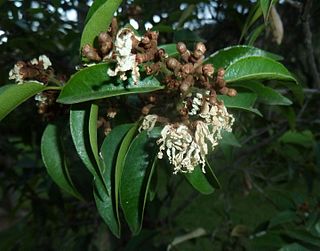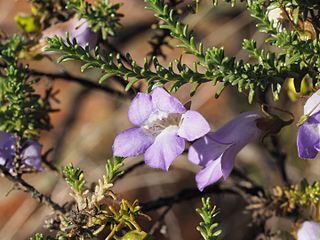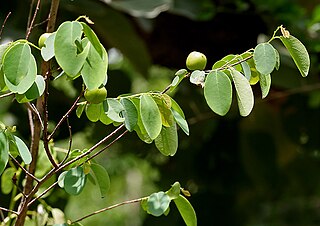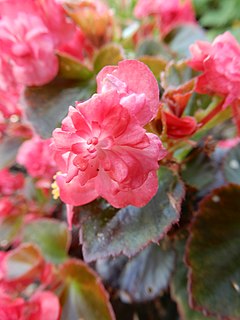
Picea breweriana, known as Brewer spruce, Brewer's weeping spruce, or weeping spruce, is a species of spruce native to western North America, where it is one of the rarest on the continent. The specific epithet breweriana is in honor of the American botanist William Henry Brewer.

Carpinus caroliniana, the American hornbeam, is a small hardwood tree in the genus Carpinus. American hornbeam is also known as blue-beech, and musclewood. It is native to eastern North America, from Minnesota and southern Ontario east to Maine, and south to eastern Texas and northern Florida. It also grows in Canada.
Alsophila heterochlamydea, synonym Cyathea heterochlamydea, is a little-known species of tree fern native to the islands of Luzon, Panay, Negros and Mindanao in the Philippines, where it grows in montane forest. The trunk of this plant is erect and usually up to 4 m tall or more. Fronds may be bi- or tripinnate and 1–2 m in length. The stipe is warty and/or bears short spines and scales. These scales are dark, glossy and have a narrow pale margin. Sori are borne near the fertile pinnule midvein and are protected by firm, brown indusia.
Alsophila imbricata, synonym Cyathea imbricata, is a species of tree fern endemic to Western New Guinea, where it grows in open forest at an altitude of 3240 m. The trunk of this plant is erect and approximately 2 m tall. Fronds may be bi- or tripinnate and are usually less than 1 m in length. The stipe is dark, spiny, and covered with caducous scales. These scales are glossy brown in colouration and have a paler margin and fragile edges. Sori are borne in groups of one to four per pinnule lobe. They are protected by firm indusia.

Abies delavayi, the Delavay's silver-fir or Delavay's fir, is a species of fir, native to Yunnan in southwest China and adjoining border areas in southeastern Tibet, far northeastern India, northern Myanmar, and far northwestern Vietnam. It is a high altitude mountain tree, growing at elevations of 3,000–4,000 m, often occupying the tree line.

Ligustrum japonicum, known as wax-leaf privet or Japanese privet is a species of Ligustrum (privet) native to central and southern Japan and Korea. It is widely cultivated in other regions, and is naturalized in California and in the southeastern United States from Texas to Virginia.

Frangula alnus, commonly known as alder buckthorn, glossy buckthorn, or breaking buckthorn, is a tall deciduous shrub in the family Rhamnaceae. Unlike other "buckthorns", alder buckthorn does not have thorns. It is native to Europe, northernmost Africa, and western Asia, from Ireland and Great Britain north to the 68th parallel in Scandinavia, east to central Siberia and Xinjiang in western China, and south to northern Morocco, Turkey, and the Alborz in Iran and Caucasus Mountains; in the northwest of its range, it is rare and scattered. It is also introduced and naturalised in eastern North America.

Cinnamomum iners is a tree species in the family Lauraceae described by Reinwardt and Blume. No subspecies are listed in the Catalogue of Life. It occurs naturally in Sri Lanka, India, Bangladesh, Myanmar, Thailand, Laos, Cambodia, Vietnam, Malaysia, Indonesia, the Philippines and southern China and south-eastern Tibet.

Merwilla is a genus of bulbous flowering plants in the family Asparagaceae, subfamily Scilloideae. It is distributed in southern Africa, from Zimbabwe to South Africa. This genus is named after the botanist Frederick Ziervogel Van der Merwe (1894–1968), who worked on this group.

Karomia speciosa is an African deciduous large shrub or bushy tree up to 7 m, and relocated to the family Lamiaceae from Verbenaceae. It is one of 9 species in the genus Karomia, a genus containing species previously classified in Holmskioldia, and is closely related to Clerodendrum. The only remaining species in the genus is Holmskioldia sanguinea, occurring in the foothills of the Himalayas.

Trichocladus grandiflorus is a species in the genus Trichocladus, in the family Hamamelidaceae. It is also called splendid witch-hazel.

Sterculia urens is a species of plant in the family Malvaceae. It is native to India and has been introduced into Burma. A small to medium-sized tree with a pale-coloured trunk, it is commonly known as the भुत्या in Marathi, kulu, Indian tragacanth, gum karaya, katira, sterculia gum or kateera gum. The specific name urens refers to the stinging hairs present on the flowers.

Eremophila exilifolia is a flowering plant in the figwort family, Scrophulariaceae and is endemic to Western Australia. It is a widely distributed shrub which is shaped like an inverted cone and has small, very sticky leaves and branches and lilac-coloured flowers.

Spondias pinnata is a species of tree first described by Carl Linnaeus the Younger. It is in the family Anacardiaceae. This species, among several others, has sometimes called the "wild mango" in other languages and was once placed in the genus Mangifera.

Cleistanthus sumatranus is an accepted name of a tree species in the genus Cleistanthus. No subspecies are listed in the Catalogue of Life.

Cleistanthus collinus is a plant species first described by Roxburgh, with its current name after Bentham and Hooker; it is included in the family Phyllanthaceae. The IUCN categorizes this species as vulnerable. No subspecies are listed in the Catalogue of Life.
Reinwardtiodendron humile is a small tree species in the family Meliaceae. There are no subspecies listed in the Catalogue of Life.

Gymnosporia buxifolia is a species of plant in the family Celastraceae native to southern Africa. The common name is common spike-thorn.
Calochilus cleistanthus, commonly known as the pallid beard orchid, is a species of orchid endemic to Queensland. It has up to four small, pale green to yellowish green flowers which remain closed and the plant is apparently leafless. It is only known from a single location on the Cape York Peninsula.

Begonia cucullata, also known as wax begonia and clubed begonia, is a species of the Begoniaceae that is native to South American countries of Argentina, Brazil, Paraguay, and Uruguay. A common garden plant and part of the section Begonia, it was described in 1805 by Carl Ludwig Willdenow (1765–1812). The specific epithet "cucullata" means "resembling a hood" or "hooded".















